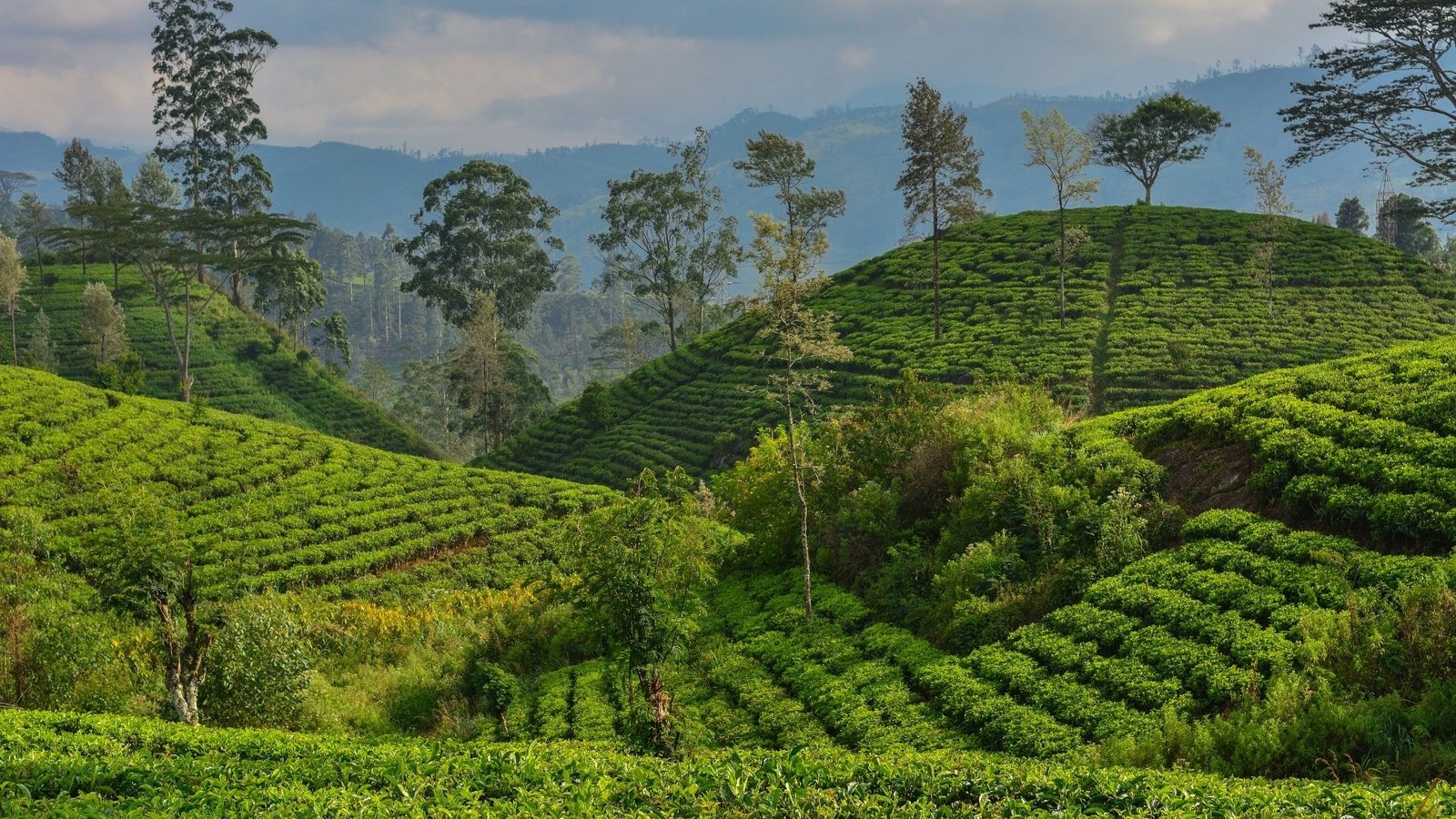Few things evoke the soul of Sri Lanka better than a steaming cup of Ceylon tea. Tea is not only an agricultural product; it has shaped the landscape, economy and identity of the country for over a century. From the mist-shrouded hills of Nuwara Eliya to the coastal Handunugoda estate near Koggala, exploring Sri Lanka’s tea culture means experiencing a living heritage. This guide delves into the history of Ceylon tea, highlights its cultural significance and suggests the most rewarding estates and regions to visit.
Why Tea Matters to Sri Lanka
Sri Lanka (formerly called Ceylon) owes much of its modern economy to tea. The island is the world’s third‑largest exporter of tea, with a market share of about 10 percent and an export industry valued at roughly US$1.3 billion. Tea isn’t just an export commodity; it’s a symbol of national pride and heritage. Ceylon tea is celebrated globally for its exceptional quality and distinctive flavours. In fact, Sri Lanka’s diverse geography and tropical climate — from misty highlands to warm lowlands — allow growers to cultivate high, mid and low‑grown teas with different characteristics.
From Coffee to Ceylon Tea: A Brief History
The island’s tea story began with failure. In the 19th century Ceylon’s hills were carpeted with coffee plants. When a fungal disease called coffee rust devastated the crop in the 1870s, planters urgently needed an alternative. Experimentation with tea had started earlier; the British introduced tea plants to Peradeniya Botanical Garden in 1824. In 1867 Scottish planter James Taylor established the first commercial tea plantation at Loolkandura estate in Kandy, cultivating just 19 acres. Taylor built a fully equipped factory by 1872, sent the first shipment of Ceylon tea to London in 1873, and thus laid the foundation for what would become one of the island’s most influential industries. By the late 19th century, almost all of Ceylon’s coffee estates had switched to tea.
Sir Thomas Lipton later propelled the industry onto the world stage. He acquired estates around Haputale and used innovative marketing to promote “Lipton’s tea” worldwide. Today Sri Lanka’s tea auction system, established in the 1880s, continues to sell almost all locally produced tea.
What Makes Ceylon Tea Special?
Several factors contribute to Ceylon tea’s fame. Sri Lanka’s varied elevations and micro‑climates produce teas with different personalities. High‑grown tea from Nuwara Eliya is light, crisp and floral — often called the “Champagne of teas.” Mid‑grown teas from Kandy are smooth and full‑bodied, while low‑grown teas from areas like Galle deliver a bold, malty flavour. Consistent rainfall, misty mornings and mineral‑rich soil further enrich the leaves.
Traditional production methods remain the norm in Sri Lanka. Skilled workers — often women from the hill‑country Tamil community — hand‑pluck just “two leaves and a bud” to ensure quality. After plucking, tea leaves go through withering, rolling, fermentation and drying to develop their aroma and flavour. Different levels of oxidation produce black, green and white teas, and final sorting and grading ensure consistency. Many estates now adopt organic and fair‑trade practices to support workers and meet sustainable standards.
Tea in Daily Life and Rituals
Tea is woven into the fabric of Sri Lankan life. Locals typically start the day with a strong black tea sweetened with sugar or milk, and serving a guest a cup of tea is a universal gesture of hospitality. Roadside tea stalls (known as tea kades) serve cheap cups accompanied by roti, samosas or buns, and act as informal meeting places. Influenced by British colonial heritage, high tea remains an elegant ritual in colonial‑era hotels where fine teas are paired with scones, cakes and savoury bites. Everywhere you go — from homes to shops and offices — you will be offered a freshly brewed cup as a sign of welcome.
Best Regions for Tea Tourism
The heart of Sri Lanka’s tea country lies in the central highlands. Visiting these lush hills gives insight into a side of Sri Lanka that goes beyond beaches and temples. Key regions include:
- Nuwara Eliya: At 1,800 m above sea level, this former colonial hill station is surrounded by historic estates. Pedro Tea Estate offers tours and tastings just outside town.
- Haputale: Slightly less polished than Nuwara Eliya, Haputale rewards visitors with working plantations such as Dambatenne, where Thomas Lipton’s legacy began.
- Ella: Accessible via a scenic train ride, Ella provides a relaxed base among tea‑covered hills. While formal tours are fewer, independent walks through working estates are ideal.
- Koggala: Near the south coast, Handunugoda Tea Estate produces rare white tea and offers short daily tours.
When to go? The best time to visit the central highlands is from January to April when the weather is dry and factories operate at full capacity. A second good window occurs between July and September, especially in the Uva region, when the “second flush” produces some of the year’s most flavourful leaves. It’s wise to avoid May and June when the southwest monsoon brings heavy rain.
Iconic Tea Estates and Experiences
Tea country isn’t just about scenery; it’s about stories. These estates allow visitors to immerse themselves in Sri Lanka’s tea heritage.
Dambatenne Estate & Lipton’s Seat (Haputale)
Sir Thomas Lipton acquired Dambatenne in the late 19th century and used it as the foundation of his tea empire. The estate’s Lipton Seat — his favourite lookout — offers panoramic views over miles of tea‑carpeted hills and, on a clear day, across seven provinces. You can tour one of the country’s oldest estates; its factory, built in 1890, still operates machinery from the 19th and 20th centuries.
Loolkandura Estate (Kandy)
Known locally as Loolkandura, this estate is the cradle of Ceylon tea. Founded in 1867 by James Taylor, it became the first commercial tea plantation. Visitors can see the original tea patch and the rock seat where Taylor used to rest, with views of the surrounding mountains. The estate still houses one of Sri Lanka’s longest tea factories (325 ft).
Halpewatte Tea Factory (Ella)
Located 6 km from Ella, Halpewatte is the largest tea producer in the Uva region. The factory, built in 1940, offers guided tours, masterclasses and tastings. Visitors can try plucking tea, create a signature blend and enjoy fresh brews and light meals at the onsite café.
Damro Labookellie Tea Factory (Nuwara Eliya)
Formerly known as Mackwoods, this estate is considered the second‑oldest on the island. Free guided tours reveal the production process from plucking to grading, and the Tea Lounge serves an impressive range of teas and snacks.
Pedro Tea Estate (Nuwara Eliya)
Established in 1885 on land where James Taylor first planted tea, Pedro still uses 19th‑century machinery. Guests can watch nimble tea pluckers at work and enjoy tea at the Lovers Leap Ethical Tea Boutique, named after the nearby waterfall.
Bluefield Tea Estate (Ramboda)
Set in the village of Ramboda, this estate produces some of Sri Lanka’s finest organic teas. Visitors can wander through the fields, pluck leaves, watch cleaning and grading inside the factory and sample exquisite blends. The estate also hosts a restaurant, pastry shop and Tea Emporium.
Dunkeld Tea Plantation (Hatton)
Sitting beside the Castlereagh reservoir near Hatton, Dunkeld is managed by Dilmah and retains machinery and methods over 100 years old. Tours of the plantation and factory, plus stays in colonial bungalows, offer a quintessential tea‑country experience.
Handunugoda Tea Estate (Ahangama)
Often called the “Virgin White Tea” estate, Handunugoda is the only coastal tea plantation in Sri Lanka and the only one producing virgin white tea. This rare and expensive tea follows an ancient Chinese ritual: pickers snip buds into a ceramic bowl while wearing white clothing, gloves and masks so that the tea is never touched by human hands. The 200‑acre estate between rainforest and ocean also grows rubber, cinnamon and coconut and offers guided tours, hands‑on experiences and tastings.
Planning Your Tea‑Country Adventure
Getting there: The journey is part of the experience. You can ride the train from Kandy to Ella, one of Asia’s most scenic routes, passing misty valleys and endless tea fields. Hiring a car with a local driver offers flexibility to stop at smaller estates, especially between Hatton, Haputale and Nuwara Eliya. In places like Ella and Haputale, you can simply walk into the fields.
What to bring: Hill‑country weather is unpredictable. Pack layers — mornings and evenings can drop below 10 °C — a rain jacket, sturdy walking shoes, water, snacks and cash. Many estates are remote and do not accept credit cards.
Responsible tea tourism: Behind the picturesque views are people doing real labor. Choose estates with fair‑trade or sustainable practices and buy tea directly from producers. Don’t hesitate to ask about working conditions; transparent answers indicate ethical operations. Support local communities by staying in small guesthouses or eco‑friendly lodges.
When to visit: Plan your trip during dry seasons (January–April or July–September), avoid heavy rains in May and June, and schedule factory tours early in the morning when production is active.
Experience Tea Your Way with a Custom Tour
Exploring tea country is more than ticking attractions off a list — it’s about soaking in misty vistas, sipping freshly brewed tea and meeting the people behind each leaf. A tailored itinerary can weave together classic estates like Dambatenne and Loolkandura with lesser‑known gems such as Dunkeld or Handunugoda, alongside experiences such as hiking to Lipton’s Seat or sharing high tea in a colonial bungalow. As a Sri Lankan tour agent, we specialise in designing personalised tea‑country journeys that fit your pace and interests. Whether you’re an avid tea enthusiast or simply seeking a tranquil escape amid rolling hills, we can handle transport, accommodations and guided tours so you can savour every moment. Feel free to reach out for suggestions or itineraries that match your travel style.
Final Thoughts
Sri Lanka’s tea culture is a tapestry of history, community and natural beauty. From the pioneering days of James Taylor to the artisanal methods still practiced at boutique estates, tea embodies the island’s resilience and hospitality. By exploring the verdant hills of Nuwara Eliya, the iconic viewpoints of Haputale or the coastal plantations of Ahangama, you connect with the stories behind every cup. Take time to sip slowly, listen to the rhythm of the pluckers’ hands and let the warm aroma of Ceylon tea reveal the essence of Sri Lanka.

